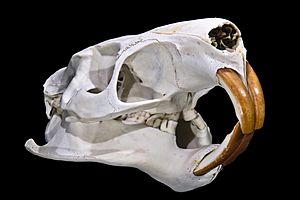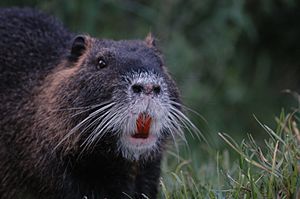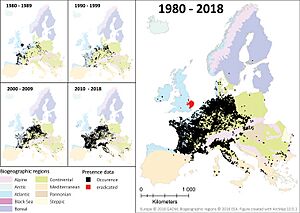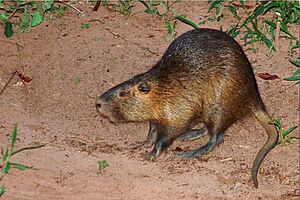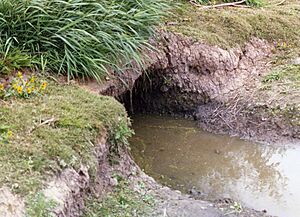Coypu facts for kids
The nutria or coypu (Myocastor coypus) is a plant-eating, semiaquatic rodent that comes from South America. It lives in burrows near water and eats river plants.
Nutrias were brought to North America, Europe, and Asia by people who raised them for their fur. Even though some people still hunt them for fur, their digging and eating habits can cause problems. They are seen as an invasive species in places like the United States. This is because they can harm the environment. Nutrias can also carry diseases that can spread to humans and other animals, often through water.
Contents
What's in a Name?
The scientific name for the nutria is Myocastor. This name comes from two old Greek words. "Myos" means 'rat' or 'mouse', and "castor" means 'beaver'. So, Myocastor means 'mouse beaver'.
In English, people use two main names for this animal: nutria and coypu. The name nutria comes from a Spanish word that means 'otter'. This name is common in North America, Asia, and some former Soviet countries. However, in most Spanish-speaking countries, "nutria" usually means 'otter'.
To avoid confusion, people in South America, Britain, and other parts of Europe often use the name coypu or coipo. This name comes from the Mapudungun language. In France, it's called a ragondin. Different countries have their own names for this interesting animal!
Nutria Family Tree
The nutria was first described in 1782 by Juan Ignacio Molina. He thought it was a type of mouse. Later, in 1792, the group Myocastor was created for it.
Scientists recognize four main types, or subspecies, of nutria:
- M. c. bonariensis: Found in northern Argentina, Bolivia, Paraguay, Uruguay, and southern Brazil. This type is believed to be the one most often introduced to other continents.
- M. c. coypus: Found in central Chile and Bolivia.
- M. c. melanops: Found on Chiloé Island.
- M. c. santacruzae: Found in Patagonia.
What Does a Nutria Look Like?
A nutria looks a bit like a very large rat or a beaver with a small, thin, hairless tail. Adult nutrias usually weigh between 4 and 9 kilograms (9 to 20 pounds). Their bodies are about 40 to 60 centimeters (16 to 24 inches) long. Their tail is 30 to 45 centimeters (12 to 18 inches) long. Some can weigh up to 17 kg (37 lb)!
Nutrias have three layers of fur. The outer layer has coarse, dark brown guard hairs. Underneath, they have soft, dense grey fur. Three things that help you spot a nutria are a white patch on its nose, webbed back feet, and large, bright orange-yellow incisor teeth. These teeth grow throughout their lives. The orange color comes from iron in the tooth enamel. Nutrias also have long whiskers, about 10 centimeters (4 inches) long, on each side of their face.
Female nutrias have their teats high on their sides. This allows their babies to feed while the mother is swimming in the water. Male and female nutrias look very similar in color and weight.
Nutrias are sometimes confused with muskrats or small beavers. Muskrats are smaller and have a flat tail that helps them swim. Nutrias have a round tail. Beavers also have flat, paddle-like tails, which is different from the nutria's round tail.
Life Cycle and Reproduction
Nutrias can live up to six years if they are kept by humans. However, in the wild, they rarely live past three years old. Most nutrias (80%) die within their first year. A nutria is considered old at four years of age.
Male nutrias can start having babies as early as four months old. Females can start as early as three months. However, some might not be ready until they are nine months old. Once a female is pregnant, her pregnancy lasts about 130 days. She can give birth to anywhere from one to 13 babies, but usually has about four. A female nutria can get pregnant again just two days after giving birth! On average, a female will have two litters of babies each year. She can have up to six or seven litters in her lifetime.
Nutria mothers make nests for their babies using grasses and soft reeds. Baby nutrias are born with fur and open eyes. They can eat plants and swim with their parents just hours after they are born. They drink their mother's milk for about seven to eight weeks before leaving her.
Nutrias can be protective if they feel trapped or threatened. They might bite or attack humans and dogs. Nutrias are mostly active around dawn and dusk, or at night. They are most active around midnight. If food is hard to find, they will look for it during the day. If there's plenty of food, they will rest and groom during the day.
Where Do Nutrias Live?
Nutrias are originally from warmer and mild parts of South America. Their native home includes countries like Chile, Argentina, Uruguay, Paraguay, and parts of Brazil and Bolivia.
They have been brought to North America, Europe, and Asia. This was mostly by people who started fur farms. Outside of South America, the number of nutrias can change a lot. This depends on how cold the winters are. In very cold winters, nutrias can get frostbite on their tails. This can lead to infection or even death. Because of this, nutria populations can shrink or even disappear after cold winters. But during mild winters, they tend to spread further north. For example, they have recently been seen spreading into Washington, Oregon, and Delaware in the United States.
In the United States, nutrias were first brought to California in 1899. By 2024, they had spread to the San Francisco Bay Area. Their digging there was threatening storm levees. These are walls built to prevent floods. The California Department of Fish and Wildlife has a program to remove them.
Nutrias were first brought to Louisiana in the early 1930s for the fur industry. Their numbers were kept low because fur traders hunted them. However, in the early 1940s, a hurricane hit the Louisiana coast. It destroyed the enclosures where nutrias were kept. This allowed them to escape into the wild. They also spread from Texas to the Mississippi River in 1941, helped by another hurricane.
Home and Food
Nutrias not only have babies quickly, but each one also eats a lot of water plants. A single nutria eats about 25% of its body weight every day, all year round. A healthy adult nutria weighs around 5.4 kg (12 lb), but some can reach up to 10 kg (22 lb).
They eat the bottom parts of plant stems that grow above ground. They also dig in the soil for roots and rhizomes (underground stems). In winter, they even eat the bark of black willow trees. When nutrias eat a lot in one area, it creates "eat-outs." These are places where most of the plants, both above and below ground, have been removed. This can harm the habitat for other animals and humans who rely on wetlands and marshes.
Nutrias eat many types of plants. These include cattails, rushes, reeds, arrowheads, flatsedges, and cordgrasses. They also eat farm crops like lawn grasses, alfalfa, corn, rice, and sugarcane.
Nutrias are most often found in freshwater marshes and wetlands. They can also live in brackish marshes (a mix of fresh and salt water). They rarely live in salt marshes. They either dig their own burrows or use burrows left by beavers or muskrats. They can even build floating platforms out of plants. Nutrias live in dens that are partly underwater, but the main room is not submerged. They are social animals and often live in groups. One male might share a den with three or four females and their babies. Nutrias also build "feeding platforms" in the water using cut plants. These are often supported by logs or branches.
Problems Caused by Nutrias
Fur Farming and Escapes
Because too many nutrias were hunted in their native South America, their numbers dropped. This led people to start nutria fur farms in the late 1800s and early 1900s. The first farms were in Argentina, and then later in Europe, North America, and Asia. These farms often didn't make money in the long run. When farms became unprofitable, the nutrias were often set free or escaped.
Nutrias were introduced to Louisiana in the 1930s when they escaped from fur farms. In 1940, a hurricane helped many nutrias escape. They quickly spread into coastal marshes and other wet areas. From Louisiana, nutrias have spread across the Southern United States. They cause a lot of damage to marshlands.
Damage to the Environment
After the demand for nutria fur went down, nutrias became pests in many areas. They destroy water plants, marshes, and irrigation systems. They also chew on man-made things like tires and wooden house parts in Louisiana. They erode river banks and push out native animals. The damage in Louisiana has been so bad since the 1950s that laws were made to deal with it. By the early 2000s, the Coastwide Nutria Control Program was started. This program began paying rewards for nutrias that were caught in 2002.
In the Chesapeake Bay area in Maryland, nutrias were introduced in the 1940s. They are thought to have destroyed 2,800 to 3,200 hectares (7,000 to 8,000 acres) of marshland. Because of this, a multi-million dollar program to get rid of them started in 2003. In the United Kingdom, nutrias were brought to East Anglia for fur in 1929. Many escaped and damaged drainage systems. A strong program by the government successfully removed them by 1989.
Nutrias eating plants "greatly reduces the total amount of plant life in wetlands." This can turn wetlands into open water. Unlike other things that disturb marshes, like fires or tropical storms, nutrias eat all year round. So, their impact on the marsh is constant. Nutrias are usually more destructive in winter. This is because there are fewer plants above ground. So, nutrias dig up roots and underground stems for food.
Wetlands are very important for both the economy and the environment. For example, the U.S. Fish and Wildlife Service found that wetlands cover only 5% of the land in the lower 48 United States. But they support 31% of the nation's plant species. These diverse systems provide food, shelter, and nesting sites for many different animals. People also get many benefits from wetlands. These include cleaner water, protection from storm surges, reduced flooding, and waste reduction. In Louisiana, wetlands are disappearing quickly. The state loses an area about the size of a football field every hour.
In 1998, the Louisiana Department of Wildlife and Fisheries (LDWF) did the first survey of the Louisiana coast. It found that plant-eating damage to wetlands totaled about 36,000 hectares (90,000 acres). The next year, the LDWF found that the damaged area increased to about 42,500 hectares (105,000 acres). The LDWF has reported that the wetlands affected by nutrias decreased from an estimated 32,000 hectares (80,000 acres) in 2002–2003 to about 2,550 hectares (6,296 acres) in 2010–2011. The LDWF says that efforts to restore coastal wetlands will be very difficult without good, long-term control of the nutria population.
Diseases Carried by Nutrias
Besides causing environmental damage, nutrias can carry a nematode parasite called Strongyloides myopotami. This roundworm can infect human skin. It causes a rash similar to "nutria itch." Nutrias can also host other parasites like tapeworms, liver flukes, and blood flukes.
Control Efforts
Nutrias are considered an alien species around the world. Their populations are watched and managed. Many countries have tried to get rid of them, with different levels of success.
Scientists believe that nutrias will spread further north in the coming century. This is because global temperatures are rising.
Nutria as Food
Some websites sell nutria meat for people to eat. In 2016, at least one restaurant in Moscow served dishes made with nutria meat. In 1997 and 1998, Louisiana tried to encourage people to eat nutria meat. Nutria meat is leaner and has less fat and cholesterol than ground beef. To encourage people in Louisiana to eat it, several recipes were shared. People in poor and rural parts of Louisiana have been trapping and eating nutria meat for many years.
A US company called Marsh Dog, based in Louisiana, received a grant. They used it to make dog food products using nutria meat. In 2012, they were recognized for finding a use for this environmentally friendly protein.
In Kyrgyzstan and Uzbekistan, nutrias are raised on private farms. They are sold in local markets as an affordable meat. In 2016, nutria meat was successfully used in a Moscow restaurant. This was part of a trend to use local foods. It appeared on the menu as a burger, hotdog, dumplings, or wrapped in cabbage leaves. People say it tastes like a mix between turkey and pork.
Images for kids
See also
 In Spanish: Coipo para niños
In Spanish: Coipo para niños


